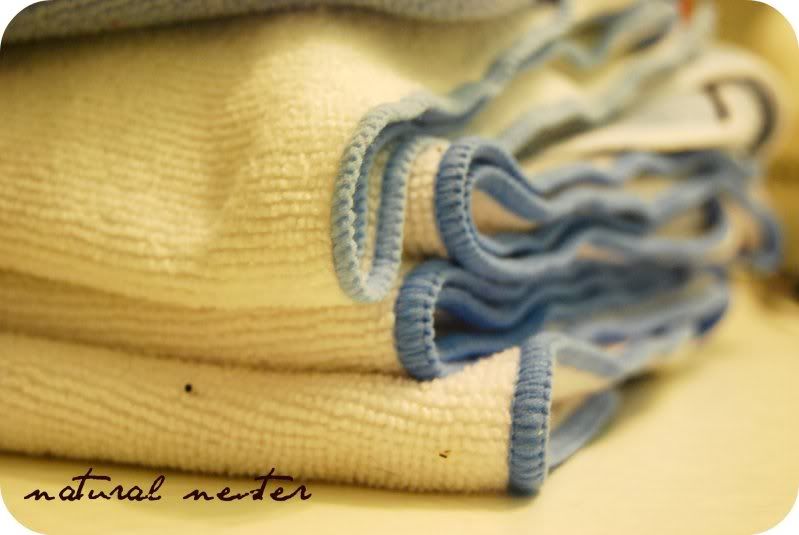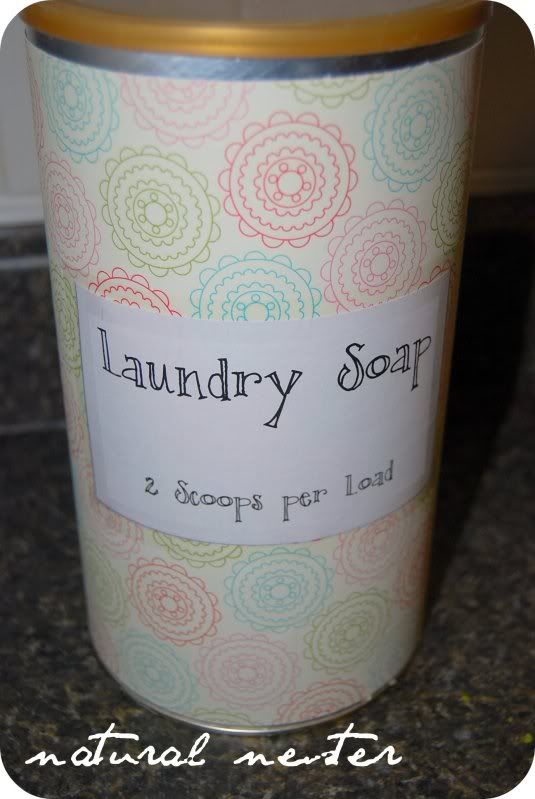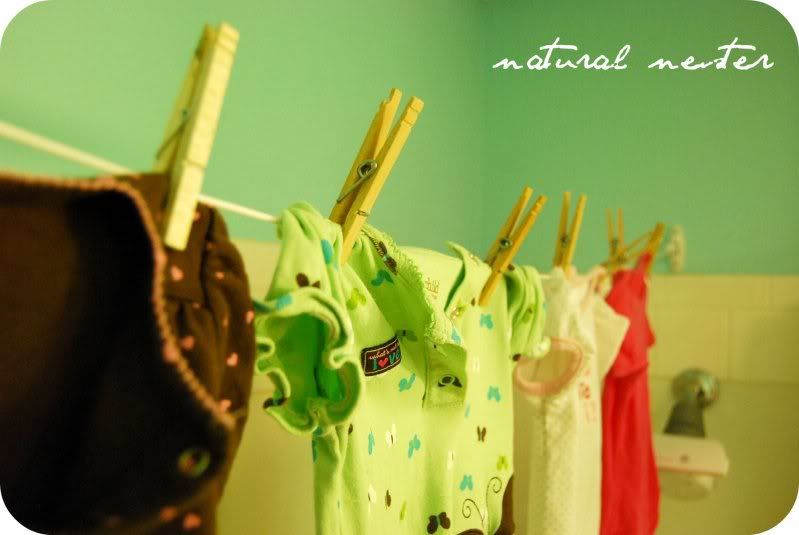Warning: This post is word-heavy. But I tried to include a lot of helpful information for you!
~~~~~~~~~~~~~~~~~~~~~~~~~~~~~~~~~~~~~~~~~~~~~~~~
I'll admit it. I used to be a cleaning product junkie. I honestly can't remember how many cleaners I used before we started going green. I know for sure I used Lysol spray, dishwasher detergent, dish washing liquid, white scrubbing cream for the stainless steel sink and microwave, a special cleaner for flat-surface stove tops...well, I could go on and on. That's a lot of cleaners and a lot of chemicals. Chemicals that we breathed in and that soaked in through my skin as I cleaned.
But at the end of last year I started reading about all those toxic chemicals and how they were affecting our health. Could it be that one of the reasons I struggle so much with illness is because my body is in toxic overload? Quite possibly! Since this was something that seemed so easy to fix, I started looking at alternatives. You can buy all types of natural cleaners at the health food store and they come with a hefty price tag. But I wanted to eliminate harsh chemicals AND save money. Turns out, it isn't so hard!
Bathroom Cleaning:
We use homemade orange disinfecting spray* to clean the sink and counter top (recipe below). The shower gets sprayed down and scrubbed with that, too. We clean it pretty regularly, so soap scum doesn't seem to be a problem, but if it gets missed (from illness or whatever), a scrubbing cream made of baking soda or borax and water works really well to get the junk off. For the toilet, a half cup or so of Borax sprinkled in works great. The toilet gets wiped down with more disinfecting spray or Thieves Household Cleaner. I know Thieves looks expensive, but you dilute it a lot, so it should last a long time. (Seriously...you dilute it 30:1 for normal cleaning!) Trashcans are sprayed with Thieves before new bags are put in...this kills odors and disinfects.
 All of our hard surface floors (bathroom and throughout the house) get swept with a broom, then run over with a microfiber cloth attached to an old Swiffer sweeper. I bought the microfiber cloths in the automotive section of Wal-Mart. I think they were 10/$5 or something....they were much cheaper in the auto section than in the cleaning section. To mop, I use the Thieves Household Cleaner diluted (about 50:1) and a sponge mop. I get almost every bit of liquid out of it, then run it over the floors. It dries quickly, doesn't streak and smells great.
All of our hard surface floors (bathroom and throughout the house) get swept with a broom, then run over with a microfiber cloth attached to an old Swiffer sweeper. I bought the microfiber cloths in the automotive section of Wal-Mart. I think they were 10/$5 or something....they were much cheaper in the auto section than in the cleaning section. To mop, I use the Thieves Household Cleaner diluted (about 50:1) and a sponge mop. I get almost every bit of liquid out of it, then run it over the floors. It dries quickly, doesn't streak and smells great. Laundry:
I love to open that dryer and smell how "clean" my clothes are. But once I realized that the smell I loved wasn't "clean" but was instead synthetic chemicals that were harming my health, it was easy to let go of that name-brand laundry detergent.
 Now I make my own laundry soap (no detergent for us!) using Cery's recipe. (There's a difference between soap and detergent...I never knew that before! Click here for a great explanation of the difference.) It takes just minutes to make and saves a bundle! I put mine in an old formula can and use the formula scoop for measuring it out because it only takes 1-2 tablespoons per load (really!) A double-batch (might as well make 2 batches in the time it takes to make one!) lasts us about 8 weeks and we do a lot of laundry! For those of you with HE washers, that's what we have and because this produces very few suds, it works great!
Now I make my own laundry soap (no detergent for us!) using Cery's recipe. (There's a difference between soap and detergent...I never knew that before! Click here for a great explanation of the difference.) It takes just minutes to make and saves a bundle! I put mine in an old formula can and use the formula scoop for measuring it out because it only takes 1-2 tablespoons per load (really!) A double-batch (might as well make 2 batches in the time it takes to make one!) lasts us about 8 weeks and we do a lot of laundry! For those of you with HE washers, that's what we have and because this produces very few suds, it works great!
Cery did the math and came up with a cost of 4 cents per load. The detergent I bought before costs at least 15 cents per load. That's significant savings in my book! I add white vinegar to the rinse water which helps break up any residue left behind from all those years of using detergent. (No, your clothes will NOT smell like vinegar...I promise!)
Instead of dryer sheets, I put my clothes in with a little lavender sachet. I also put a few drops of therapeutic grade lavender essential oil on the sachet before sticking it in the dryer. My clothes still smell clean, but not chemically-fragranced.
I have also just installed a retractable clothesline (purchased for about $5) above my shower for hanging delicates and anything with snaps. Those little snaps get snagged in our dryer and could eventually lead to a costly repair bill. It only takes a minute to pull out those few items and hang them up when I switch out laundry. I like it so much I think I'll install a backyard clothesline this spring! What a great way to save energy AND use the power of the sun's disinfecting rays!
I hope this information is helpful to some of you! Going green is certainly a process...I'm sure there are many more things we can do to go green, but just remember, you don't have to do it all today! Make just One Little Change for the benefit of your family!
And now for the recipes:
Orange Vinegar
Place the peels of several oranges in a container and cover with vinegar. Leave in a cool, dark place for 1-2 weeks, gently shaking every few days. When vinegar has turned orange, strain out the peels and use this vinegar in place of regular vinegar for all your cleaning needs.
Orange Disinfecting Spray
1/4 cup Orange Vinegar
2 t borax (less than half a cent)
1/4 C liquid castille soap
2 C hot water
Place all ingredients in a spray bottle. Shake before each use. Spray surface and wipe down with paper towel or reusable cleaning cloths. Works great for counters, tables, high chairs, sinks, stove tops, microwaves, etc.
*I got the recipe for Orange Vinegar and Orange Disinfecting Spray from Grocery Shrink. If you go to her site, you can sign up for her newsletter and you'll get 2 emails full of cleaning recipes. This is my favorite one. But go sign up! Each newsletter is full of great ideas on ways to save money and she even includes a Q&A section. It's well worth a visit to her website!
Powdered Laundry Soap
Powdered Laundry Soap
 |
| Laundry Soap Ingredients |
1 cup 20 Mule Team Borax
1 cup Washing Soda (NOT baking soda!)
1 bar soap of your choice (I use Fels-Naptha laundry bar.)
Grate your bar of soap using a cheese grater (the finer the grate, the better.) If your soap is very sticky or full of moisture, let it sit out on the counter for a day or two, or put it in the oven (200-250 degrees) until dried out. Crumble soap until it is super-fine, then mix with the Borax and Washing Soda. Store in an airtight container and use 1-2 Tablespoons per load (depending on how soiled the load of clothes is.)
If you prefer liquid laundry soap, visit Cery's blog here for directions.
A note for locals: I got my Fels-Naptha soap at Consumer's IGA for $1.29 a bar. You can also use Zote soap which I have seen at Big Lots (and it's about 30 cents cheaper per bar!) Both are natural alternatives to chemically-fragranced, petrol-based soaps from the personal care aisle.

1 cup Washing Soda (NOT baking soda!)
1 bar soap of your choice (I use Fels-Naptha laundry bar.)
Grate your bar of soap using a cheese grater (the finer the grate, the better.) If your soap is very sticky or full of moisture, let it sit out on the counter for a day or two, or put it in the oven (200-250 degrees) until dried out. Crumble soap until it is super-fine, then mix with the Borax and Washing Soda. Store in an airtight container and use 1-2 Tablespoons per load (depending on how soiled the load of clothes is.)
If you prefer liquid laundry soap, visit Cery's blog here for directions.
A note for locals: I got my Fels-Naptha soap at Consumer's IGA for $1.29 a bar. You can also use Zote soap which I have seen at Big Lots (and it's about 30 cents cheaper per bar!) Both are natural alternatives to chemically-fragranced, petrol-based soaps from the personal care aisle.



No comments:
Post a Comment